The Samsung Galaxy S6 and S6 edge Review
by Joshua Ho on April 17, 2015 9:00 AM EST- Posted in
- Smartphones
- Samsung
- Mobile
- Galaxy S6
- Galaxy S6 Edge
System Performance
In order to test the Exynos 7420 and the phone in general, we turn to our suite of benchmarks which are able to show how the device performs in common general computing workloads. Something as simple as web browsing is still surprisingly intensive on mobile phones, and in general Android can often be quite stressful to run in the constraints of a ~3W total TDP especially on any phone still running Dalvik due to its strong reliance on bytecode and a virtual machine that translates bytecode to machine code just before and during application runtime. ART improves this significantly, but is limited in the nature of optimization as AOT compilation optimizations are limited by the CPU power of the SoC and the need to compile the application in a reasonable amount of time.
As always, we'll start things off with our browser benchmarks. After getting to use the phone, it became clear to me that Chrome is poorly optimized against the Galaxy S6 as Samsung’s browser is clearly superior in performance. For that reason I've gone ahead and run our benchmarks on both Chrome and on the stock browser, as seen below.

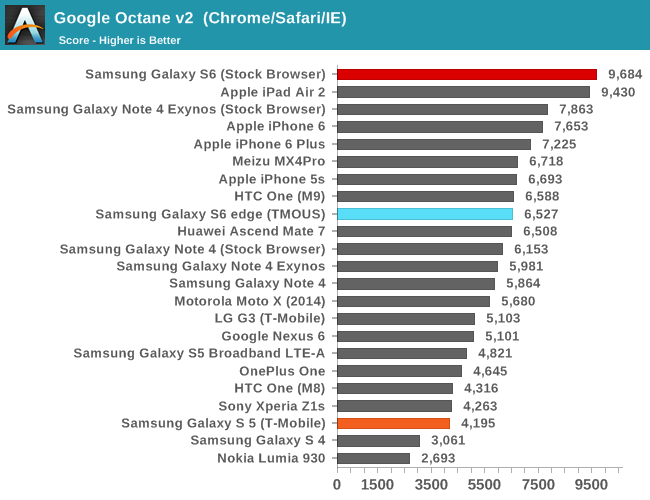

Needless to say, in order to see the full potential of the Exynos 7420 and its cluster of A57s, it’s necessary to use Samsung’s stock browser. This performance is really quite amazing when compared to Apple’s A8X, which has basically been the gold standard for performance in the mobile space in the context of ARM SoCs.
Moving on, as a part of our updates to the benchmark suite for 2015, we'll take a look at Basemark OS II 2.0, which should give a better picture of CPU performance in addition to overall device performance.
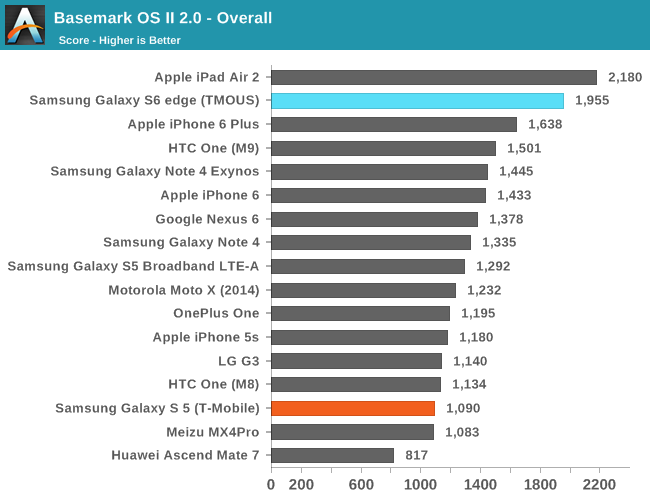
The browser benchmarks seem to hide some pretty enormous variability as the Galaxy S 6 edge (which is comparable to the Galaxy S 6) sets a new record among Android devices. The only challenger is the iPad Air 2, which uses the A8X SoC with three Enhanced Cyclone cores and the semi-custom GXA6850 GPU.
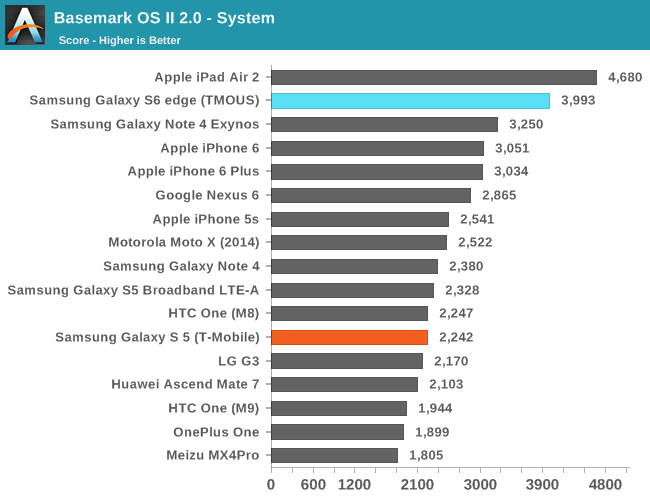
This system test contains a floating point and integer test, in addition XML parsing, which means that this test mostly stresses CPU and RAM. Interestingly enough, the Exynos 7420 pulls far ahead of both the Exynos 5433 and Snapdragon 810 in this test, and approaches the A8X. The difference between the 5433 and 7420 is likely a combination of the higher clocks on both the A57 and A53 clusters for the 7420 (1.9/1.3 on the 5433, 2.1/1.5 on the 7420), in addition to the ability to stay at a high 'overdrive' clock due to reduced leakage from the 14LPE process. The One M9 likely falls a bit short here due to HTC's governor settings restricting the use of all 8 cores simultaneously.

While one might guess that the memory test of 'Basemark OS II 2.0 - Memory' is of RAM, this is actually a test of the internal storage. Once again we see the S6 edge come close to leading the pack due to the use of the new UFS (Universal Flash Storage) standard. Casual examination reveals that the S6 edge has a queue depth of 16, and that it identifies itself with the rather cryptic model name of KLUBG4G1BD-E0B1.
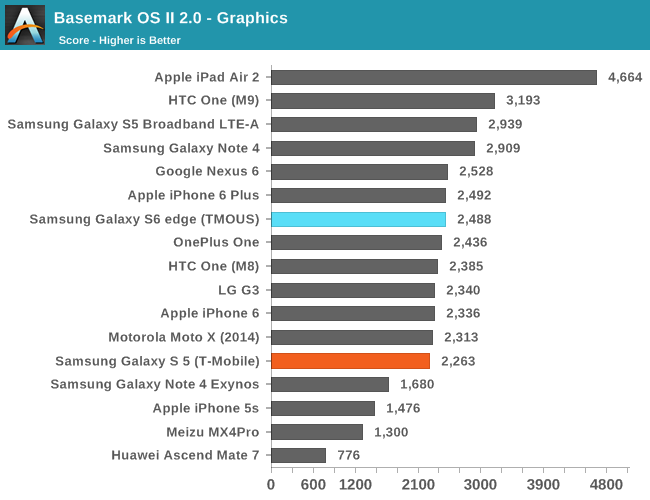
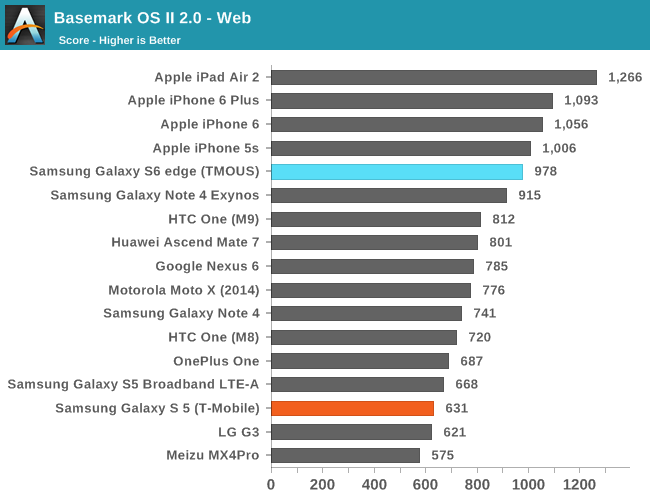
For the web test, it uses the built-in WebView rendering engine rather than Chrome and paints a distinctly different picture, especially because these tests are focused on HTML5 and CSS rather than JavaScript. Here we can see that the iPhone 6 and iPad Air 2 continue to hold their lead, but the Galaxy S6 is pretty much the king of the hill when it comes to Android devices.
Our next system benchmark is PCMark, which does a number of basic benchmarks designed to stress various aspects of the device in everyday workloads like video playback, web browsing, text editing, and photo editing. This tends to test every aspect of a mobile device, unlike microbenchmarks that can often miss aspects of the system that can affect performance.
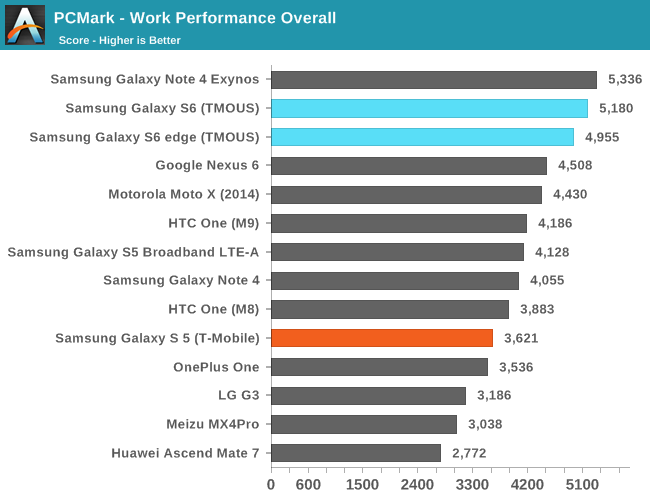
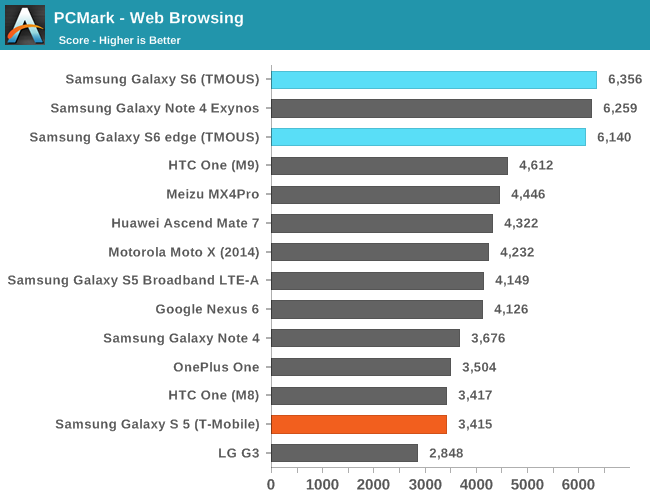
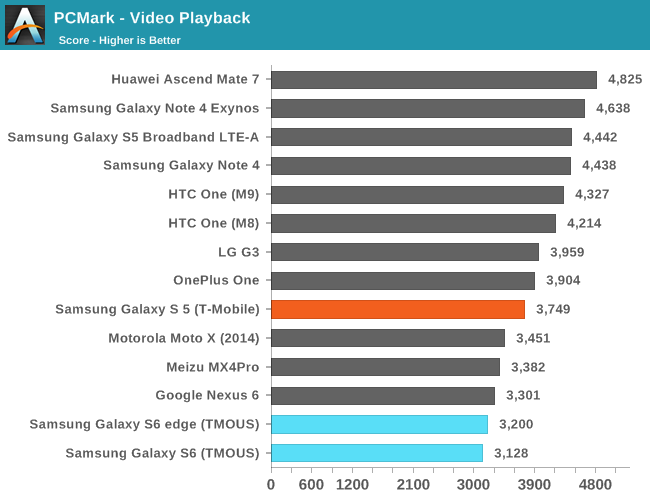
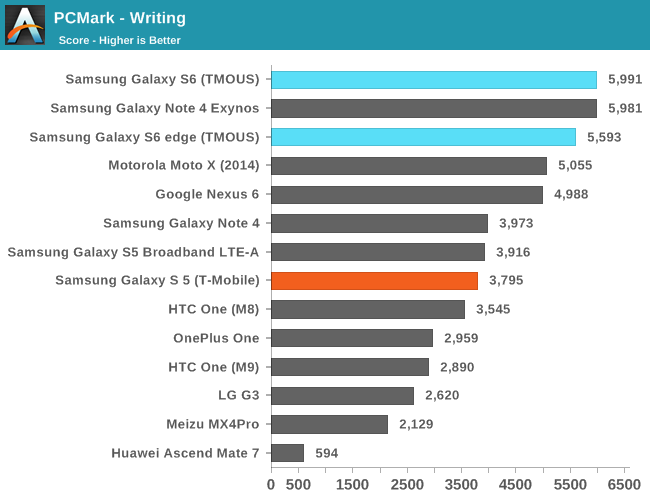

In these tests, the Galaxy S6 continues to perform strongly here due to the fast NAND storage solution and the Exynos 7420 SoC. As we have already covered the Basemark OS II 2.0 results in previous articles, I would refer back to it as those scores are final and have already been contextualized.
Overall, in these general purpose computing tasks that stress CPU, memory, and NAND performance we can see that the Exynos 7420 is off to a flying start. Samsung Mobile should focus more strongly on optimizing the software stack against Chrome as mobile Chrome has around twice the user share of stock Android browsers. I often say that the SoC is the foundation to a good smartphone, and in the case of the Galaxy S6 it feels like this is especially true.










306 Comments
View All Comments
CrazyElf - Friday, April 17, 2015 - link
I just hope the Note 5 comes with expandable storage and a removable battery.Equally annoying is that it as lost waterproofing. On paper at least, it should be easier to waterproof a phone with no removable battery. That and accidents happen. The glass back too is form over function. Give us a metal back or something like carbon fibre.
whiteiphoneproblems - Friday, April 17, 2015 - link
Playing with the Edge, I noticed that the curves of its screen create undesirable light reflections. Any comments on this?JoshHo - Friday, April 17, 2015 - link
I noticed interference effects as well, which is discussed in the display section. Overall there are some notable compromises with the edge with relatively little benefit. Combined with the steep price increase and I find it hard to justify buying one over a 64 GB GS6.whiteiphoneproblems - Saturday, April 18, 2015 - link
Thanks - sorry to make you repeat yourself.nyonya - Friday, April 17, 2015 - link
Great review! Any chance you guys will get a Verizon or Sprint variant? Would love to see the battery life tests with the Qualcomm modem in those.victorson - Friday, April 17, 2015 - link
Nothing about the front facing camera?Ammaross - Friday, April 17, 2015 - link
It's a selfy-cam. Don't like it? Take pictures in the bathroom mirror like the rest of them. I doubt Skype et al pixelated video chat will care about slight distortions at the edge of the FoV or slight aliasing for striped objects, etc. :Pjohnnohj - Friday, April 17, 2015 - link
The S5 (and Note 4?) used to have a serious problem with edge distortion on the front-cam. I wonder if it's present on the S6.See this thread for examples http://forums.androidcentral.com/samsung-galaxy-s5...
akdj - Sunday, April 26, 2015 - link
I've got the Note 4, can't comment on the S5. I've never used one. But the Note 4, if so inclined allows you to take 'selfies' with the front (main) camera. You set your phone where you want it (actually according to where you want you;)) -- it looks slick. I've never used it. You frame/focus/lock exposure where you'll be 'posing' yourself or with a group. Take position. It recognizes a face. Flashes a light, counts down a couple seconds and snaps.Regardless, they're using a nice wide aperture and high megapixel selfie cam (that also shoots decent 1080p video for conferencing). It's definitely a step 'up' from most of the competition including the iPhone (I'm ambidextrous, the 6+ is my personal phone. I run our business with the Note4). Note 4's 'selfie' cam definitely beats up on my iPhone's. But then again, FaceTime is extremely cool, more reliable than Skype and convenient that Voice. Be cool if one of the three would open their face 'facing' software as open source/X-Platform, secure and not subsidized by data mining/search dollars or near trillion dollar company servers like Apple's.
More n more fills are using this camera, not necessarily for selfies but conferencing and team meetings. Between the two I've got, while the Note's is a better face cam IMHO, it's slight. And that's for both front and rear. They're both phenomenal in comparison to the 2007 iPhone I owned, the '08 Android, and any iPad or Xoom/Nexus I've owned --- and with a ten year old son, going through Google's Drive photos/Picassa and iCloud, both of which I was using pre 2007 for email and DSLR & visual storage or transfer, I'm now able to watch my son grow up in front of the computer.
So much different than my mom's photo albums of my three younger brothers ( all of us married, with kids now) & I.
These cameras and their storage software/data management subsystems have grown in leaps and bounds in the past couple years ...ita going to be interesting in thirty years to see what my son's 'photo albums' look like. If you were born in the last decade, your entire LIFE will be online and documented photographically
Practice Safe Selfies! I've got stories from friends about watching 'slide shows' with their teenagers or college kids that are hilarious! I'm not so sure they need to improve selfies significantly -- beyond today's capabilities. There's a fine line between too much detail and improved clarity on a wide angle closely focused, and hence distorted facial or grainy 'length' shots. I think nearly all selfie cams suffer not only edge distortion but soft corners/vignette, low resolution, tiny sensors and bad skin tones. They're more than fine for casual web shots but I don't want to see the pores of the race of the person I'm chatting with. Too distracting!
akdj - Sunday, April 26, 2015 - link
Ugh!*Edit* paragraph two is supposed to say 'More folks' not fills.
**Edit 2** last, main sentence '..the (f)ace of the person I'm chatting with!'
J